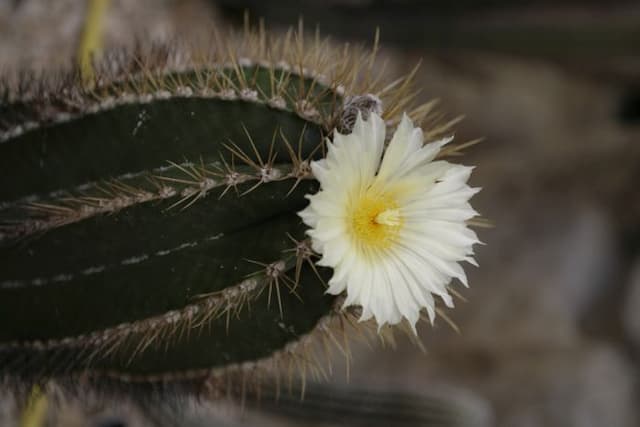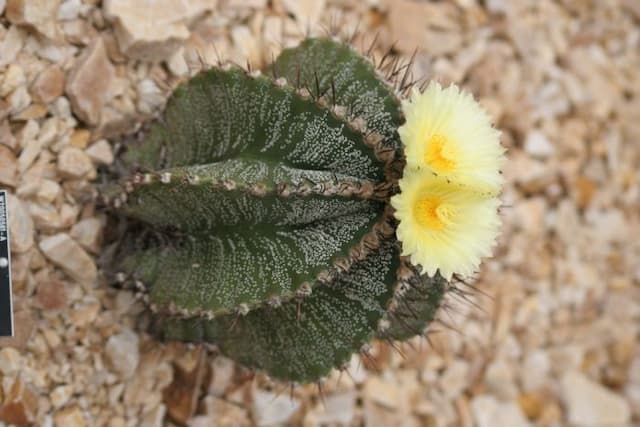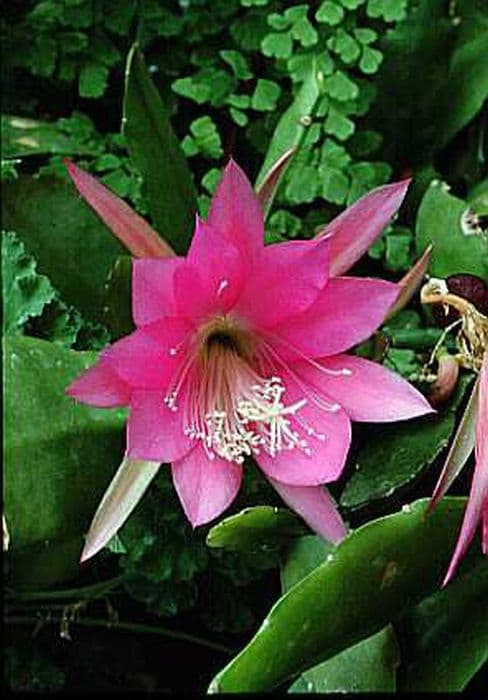Cleistocactus strausii

ABOUT
The Silver Torch Cactus is a strikingly beautiful plant characterized by its columnar growth habit, developing multiple slender, cylindrical stems. These stems are densely covered with silvery-white spines that almost entirely cloak the green underlying tissue, giving the plant its common name. The spines not only protect the cactus but also reflect sunlight, helping to regulate the plant's temperature. Each stem is adorned with areoles, from which the spines emerge, creating a woolly appearance. During its flowering period, the Silver Torch Cactus produces vividly colored flowers that emerge from the sides of the stems. The flowers are typically tubular and can be red, orange, or purple, adding a stunning contrast to the silvery sheen of the spines. These blossoms are usually long-lasting and appear close to the top of the stems. Overall, the Silver Torch Cactus is an architecturally appealing plant that is often sought after for its unique and eye-catching presence in gardens and indoor settings. Its distinctive color palette and texture make it a popular choice among cactus enthusiasts and those looking to add a touch of exotic flair to their plant collection.
About this plant
 Names
NamesSynonyms
Silver Torch, Wooly Torch, Snow Pole, Wooly Cactus
Common names
Borzicactus strausii, Cleistocactus baumannii, Cereus strausii.
 Toxicity
ToxicityTo humans
The Silver Torch Cactus (Cleistocactus strausii) is not known to be toxic to humans. However, it is important to note that the spines on these cacti can cause physical injury if handled without care. Ingestion of any part of this plant is not advised as it could potentially lead to gastrointestinal discomfort due to the plant's fibrous nature, but toxicity from ingestion is not a common concern.
To pets
The Silver Torch Cactus is similarly not known to be toxic to pets. The primary concern with pets, as with humans, is the physical harm that can be caused by the sharp spines of the cactus. Ingesting the plant may lead to gastrointestinal upset in pets, such as vomiting or diarrhea, due to the irritation caused by its fibrous material; however, there is no specific toxicity associated with this plant.
 Characteristics
CharacteristicsLife cycle
Perennials
Foliage type
Evergreen
Color of leaves
Green
Flower color
Red
Height
10 feet (3 meters)
Spread
2 feet (0.6 meters)
Plant type
Cactus
Hardiness zones
9
Native area
Bolivia
Benefits
 General Benefits
General Benefits- Ornamental Value: The Cleistocactus strausii, commonly known as the Silver Torch cactus, is prized for its striking columnar shape and silvery spines, making it a popular choice among cactus enthusiasts and for landscape decoration in arid gardens.
- Drought Tolerance: As a succulent, the Silver Torch cactus is highly drought-tolerant, requiring minimal watering and well-suited to xeriscapes or regions with water restrictions.
- Ease of Care: This cactus is relatively low-maintenance, withstanding neglect and the common pitfalls of overwatering and inadequate lighting that affect other houseplants.
- Longevity: Cacti, including the Silver Torch, often enjoy a long lifespan, providing an enduring presence in a garden or as a houseplant.
- Pollinator Attraction: When in bloom, the Silver Torch cactus produces colorful flowers that attract pollinators such as bees, benefiting the ecological balance of the garden.
- Vertical Interest: With its upright growth, the Silver Torch cactus adds vertical interest and contrast to gardens, especially in rocky or desert-themed landscapes.
- Cultural Significance: Cacti often have cultural and historical significance in the regions they originate from, and can be used to educate and connect with those cultural heritages.
- Space Saving: Due to its vertical growing habit, the Silver Torch cactus is ideal for gardeners with limited space, both outdoors and indoors.
- Adaptability: This cactus has the ability to adapt to a variety of soil types provided they are well-draining, making it versatile for different garden conditions.
 Medical Properties
Medical PropertiesThis plant is not used for medical purposes.
 Air-purifying Qualities
Air-purifying QualitiesThis plant is not specifically known for air purifying qualities.
 Other Uses
Other Uses- Cleistocactus strausii, commonly known as the silver torch or wooly torch, can be used in xeriscaping, a landscaping method that reduces the need for irrigation.
- The plant can serve as a living barrier due to its height and spiky texture, deterring small animals and unwelcome foot traffic.
- The long, columnar form and silvery-white spines of the silver torch can be utilized as a striking architectural feature in garden design.
- Its blooms attract hummingbirds, offering a natural way to bring pollinators and wildlife interest to a garden space.
- The silver torch, when planted in groups, can create a dramatic visual impact with their upright growth habit, providing a sense of vertical rhythm in a landscape.
- As an ornamental, the plant is often used in pots for patios and balconies, where its unique shape adds an exotic touch.
- Large specimens can be used as focal points in rock gardens to mimic their native Andean mountain habitat.
- Due to its resilience and low water requirements, it is ideal for use in educational settings to teach about drought-tolerant planting and desert ecosystems.
- It can be used in artistic installations and as part of living sculptures in garden exhibitions to showcase its otherworldly appearance and texture.
- The silver torch can be planted alongside other cacti and succulents to create a collection that demonstrates the diversity of shapes and sizes within desert-adapted plants.
Interesting Facts
 Feng Shui
Feng ShuiThe Silver Torch is not used in Feng Shui practice.
 Zodiac Sign Compitability
Zodiac Sign CompitabilityThe Silver Torch is not used in astrology practice.
 Plant Symbolism
Plant Symbolism- Resilience: The Cleistocactus strausii, commonly known as the Silver Torch Cactus, is native to high altitudes in Bolivia and Argentina, where conditions are tough. Its ability to thrive in harsh environments symbolizes resilience and endurance through difficult times.
- Protection: The Silver Torch Cactus is known for its dense spines that cover its columnar stems, which can be seen as a natural defense mechanism. Symbolically, it represents protection and the idea of safeguarding oneself or loved ones from harm's way.
- Adaptability: This cactus species can adapt to extreme drought and survive with minimal water, symbolizing adaptability and the importance of being able to thrive in changing conditions or environments.
- Patience: The Silver Torch Cactus grows slowly and takes years to mature and bloom, symbolizing patience and the understanding that some things take time to develop and flourish.
- Loneliness or Solitude: Often found standing alone in its natural habitat, the Silver Torch Cactus can represent loneliness or the value of solitude and self-reflection.
 Water
WaterThe Silver Torch Cactus should be watered sparingly. During the active growing season in spring and summer, watering once every two to three weeks is sufficient. It's important to ensure that the soil is well-draining and to let it dry out completely between watering sessions. When watering, provide enough water so that it runs out of the drainage holes, which could be around 16 to 32 ounces for smaller pots. During fall and winter, reduce the frequency to once a month or less, as the plant enters a dormant period.
 Light
LightThe Silver Torch Cactus thrives in full sun to light shade. Place it in a location where it receives at least six hours of direct sunlight daily. If grown indoors, a south-facing window is an ideal spot to provide the intense light this cactus requires for healthy growth. Insufficient light may result in poor flowering and etiolation.
 Temperature
TemperatureThe Silver Torch Cactus prefers temperatures between 50°F and 90°F. It can withstand brief periods of cold down to about 20°F but frost can severely damage it. To ensure optimal growth, avoid exposure to temperatures below the minimum threshold, and always protect the plant from frost.
 Pruning
PruningPruning the Silver Torch Cactus is generally not necessary, but any dead or damaged spines can be gently removed for aesthetic reasons. The best time for any cleaning or maintenance pruning is during the spring, before the cactus begins its active growth.
 Cleaning
CleaningAs needed
 Soil
SoilThe Silver Torch Cactus (Cleistocactus strausii) thrives in a well-draining cactus mix with coarse sand and perlite or pumice. Aim for a slightly acidic to neutral pH between 6.0 and 7.5.
 Repotting
RepottingThe Silver Torch Cactus should be repotted every 2-3 years or when it outgrows its current pot, which helps refresh the soil and enhance growth.
 Humidity & Misting
Humidity & MistingThe Silver Torch Cactus prefers low humidity levels, typical of arid environments. Aim to keep the humidity around 10-30%.
 Suitable locations
Suitable locationsIndoor
Place the Silver Torch Cactus in bright, indirect light and well-draining soil.
Outdoor
For outdoor growth, provide Silver Torch full sun and protect from heavy rains.
Hardiness zone
9b-11 USDA
 Life cycle
Life cycleThe Silver Torch or Wooly Torch (Cleistocactus strausii) starts its life as a seed, which upon germination, produces a small cactus seedling with just a few spines. This cactus favors a gritty, well-draining soil mix and proliferates in bright light conditions, slowly developing a columnar shape. As it matures, the Silver Torch can reach up to 2.5-3 meters in height, with the cactus producing dense white to silvery spines that cover its surface, giving it its namesake appearance. Flowering usually occurs in adult plants during the summer months, when they can produce tubular red or burgundy flowers near the top of their columns. These flowers are pollinated by hummingbirds or insects, leading to the production of small fruit that contain seeds for the next generation. Over many years, the Silver Torch may produce offsets at its base or lower part of the stem, allowing the plant to slowly form a cluster.
 Propogation
PropogationPropogation time
Spring-Early Summer
The Silver Torch cactus, Cleistocactus strausii, is commonly propagated through stem cuttings, particularly during the warmer months when the plant is actively growing. To propagate the Silver Torch using cuttings, a healthy stem segment is carefully removed from the parent plant using a sharp, sterilized knife or pair of pruning shears. It's important to let the cut end of the segment callous over for a few days to a week to prevent rot when it is planted. Once the end is calloused, the cutting is placed in well-draining cactus soil mix, ensuring that the cut end is buried about an inch deep. Watering should be done sparingly until the cutting has fully rooted, which may take several weeks. During this initial period, keeping the cutting in a bright location with indirect sunlight is crucial to encourage root growth without causing sunburn.









